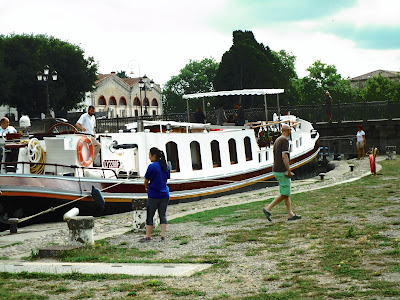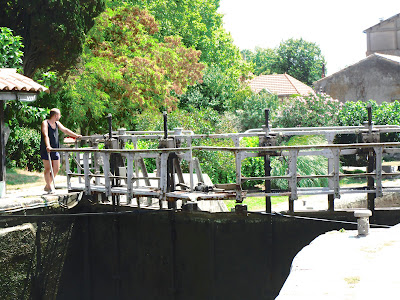In the last hour before the locks closed last night, a horde of hire
boats arrived in the port at Carcassonne, docking in the crowded harbour, with a
gusty wind on the beam (from the side), with mixed success. One crashed into the boat next but one
to us, but missed us. They all seemed very jolly, with children running around
yelling well after 10 p.m., music (or rather rap) blaring, and jovial dinner
parties taking place on flying bridges.
We worried that if they all tried to get into the first lock
at 9 a.m., the chaos would be complete. So we determined to get going early and
put ourselves at the head of the queue. That would have worked, but for
Alouette.
Alouette is a very upmarket hotel barge, taking just four
passengers for a modest 28,000 euros a week in the high season.(yes 28,000 - you could buy Saskia twice for that!). The staff passenger
ratio is one to one, and the chef highly qualified. All wines are, naturally,
included.
So our quick getaway plans were thwarted, and we went
through with a large British (blue ensign) flagged boat with a powerful bowthruster, and a hire boat, whose
first lock entry was rather alarming. Collision protection in order.
However, we sorted ourselves out and proceeded in an orderly
manner down to Trèbes, where there is the Pont de la Rode, built 340 years ago (1686) by the great fortress builder
Vauban. It still looks pretty solid after all these years.
We had to stop for lunch just before the three-chambered
lock on the east side of town. Fortunately there was a little shop selling
home-made jams and confits, as well as wine, so we spent a few euros there. Meanwhile,
of course, Alouette was making her slow and stately progress down the lock.
Never mind. Here we are going down.
Here is the lock chamber filling.
And here is the patient lock-keeper waiting.
Despite the wind, which was blustery all day, making getting
into the locks and tying up quite tricky, we made good progress. We were quite
surprised to see these boys jumping in the canal – partly because it hasn’t
been a very warm day, but mostly because the water looks distinctly murky and
uninviting. But I suppose teenagers don't notice that sort of thing.
We overtook Alouette, but to no avail. She simply sailed
past us and into the next lock. The hotel barges always have priority.
However, now we have a cunning plan. She has stopped for the night and will get
the first locking at 0900 tomorrow – but we are two locks further down the canal,
tied up to some trees in the wild. So we should be safe.





















































